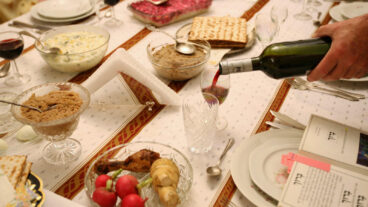Students use Miri Golan’s techniques – ‘I felt origami can and should be practiced not only as a hobby but also as a didactic tool.’Miri Golan was a young girl when she first became acquainted with the joys of the art of folding paper – which she later learned was the Japanese tradition of origami.
The pastime so captured her that it moved beyond a childhood hobby, and the Israeli decided to delve further into the subject as a young woman. In her twenties, Golan traveled to Japan where she spent a year studying this special and delicate craft – a journey which led her upon her return to Israel to found the Israel Origami Center and later develop Origametria – an innovative method for teaching geometry through origami.
“The Japanese were quite surprised by the interest a western person like me discovered in such an art form which is part of their tradition and culture. However, for me this appeal was merely natural and on my return to Israel I searched for ways to combine my two passions – origami and education,” Golan told ISRAEL21c.
“I felt origami can and should be practiced not only as a hobby but also as a didactic tool. My background in informal education assisted me in writing an educational program aimed to develop learning skills through origami.”
At first the Herzliya resident was rejected by school principals who advised her to settle for offering origami lessons at the local community centers. Her breakthrough took place when she was given the ‘go ahead’ by the Tel Aviv municipality and began teaching at the Broshim Special Education School. Her remarkable success with these children paved the way to other schools.
“Some dyslexic children suffer from rage attacks, but origami helps them relax and concentrate. Moreover, these children are highly intelligent but their difficulty to read and write often damages their self-esteem and leaves them feeling like failures. I remember overhearing one of my students passing by my classroom and saying to himself… ‘this is the room where things went right for me,'” she recalled with a smile.
Following her success in teaching origami to elementary school students Golan went on to develop Origametria. This method uses the already existing elements of geometry in origami and emphasizes them during the teaching process. In the act of preparing an origami model one is bound to create different geometric shapes. Hence, the pupil can visualize these sometimes-abstract notions in the process of preparing the model.
“Between the ages of three to nine, a window of opportunity is opened for us as teachers since the child’s imagination is extremely developed during this time. But this window of opportunity is often missed by the education system as geometry is taught at junior high when the student’s mind is often preoccupied with other issues,” explained Golan.
As of 2005, Origametria was administered successfully in 75 schools – both Jewish and Arab – to 10,000 children from the first to the eighth grade.
Last September, Golan was invited to the International Scientific Conference on Origami in Science, Mathematics, and Education at Cal Tech, where she delivered a keynote speech. In this conference some 70 scientists, artist and educators from all over the world exchanged views and explored this fascinating interaction of origami and science.
“I was approached by Robert Lang, one of the organizers of the conference who is also an origami artist and a renowned scientist. It was a great honor and an inspiring experience for me to meet with Lang and other leading scientists and educators who all use origami in their scientific work,” declared Golan.
Golan also took advantage of her stay in Los Angeles to meet with some representatives of the Jewish community. Joel Stern, a leading member of the community with great interest in origami helped her to make the most of the little time she had.
“My involvement with Ms. Golan began through her ‘Folding Together’ project, a private peace initiative which strives to build bridges between Jewish and Palestinian children using origami as a tool. Obviously, I offered to try to help her raise the funds necessary to continue this worthy and inspiring project. In the few days of free time she had available, I introduced her to a number of people in the Jewish community who I thought could be instrumental in helping her organization,” he said.
Stern was genuinely impressed with Golan’s Origametria method and the two resumed to introduce it to Los Angeles Jewish teachers as a way to cultivate a deep and lasting relationship with the Jewish community of LA.
“Origami is not a very know form of art and people tend to treat it as an odd and unusual hobby but gradually as people will become more aware to the its beauty and charming simplicity they will lean to appreciate it as a significant art and in Miri’s case a creative and powerful learning device,” he explained.
During her visit, Golan met with numerous personalities and organizations among which Esther Netter, founder of the Jewish Children’s Museum in LA and representatives of the Progressive Jewish Alliance that aims to reach out to the local Muslim community. She also met with some representatives of teachers to whom she represented the teaching techniques of Origametria.
“We succeeded in planting a few seeds, and began strategizing on other ways for her to become better known to the community. Recently, I began introducing the Origametria concept to administrators at Sinai Akiba Academy, Pressman Academy, and the LA Bureau of Jewish Education,” said Stern.
Currently Stern is preparing Golan’s second visit to LA during which she intends to meet with the Bureau of Jewish Education and will hold a training seminar for teachers.
Back in Israel, though, the Origametria studies are full steam ahead.
“The Origametria class is quite popular among the students and every week more pupils wish to join us,” Merav Zamir, a teacher of Origametria at the Bnei Zion elementary school in moshav Bnei Zion near Ra’anana told ISRAEL21c. “This lesson is not part of the school’s curriculum but given as an optional class as part of whole day dedicated to informal learning. During the day students are entitled to choose the subject they wish to learn but it seems that this specific lesson is highly demanded.
“In our lessons pupils are engaged with a creative art and at the same time are being exposed to the beauty and creativity of geometry. Therefore this lesson is valuable for both the pupils and their math teacher. In some schools I work in full coordination with the class’ math teacher and plan my lessons according to the material she intends to teach in class.”
“This is the first year we’ve taken Origametria and I truly enjoy these lessons,” says Inbar, a sixth grade student at Bnei Zion. “I had no previous knowledge of Origami but now it became part of my world. I fold Origami in my spare time and give it as presents to my friends and family. I even prepared a box for my grandfather on his birthday,” she proudly declares.
Haya Michaelis, the school’s principal, said she had her share of doubts when introducing Origametria to her students. However, the positive feedback she’s been receiving from them several months after the subject is being taught dismissed her reservations. In addition, she intends to offer the subject to the first year’s students as well.
“In our school senior students tutor first year ones and to my surprise I discovered that those students who take Origametria later on teach it to the young ones. Therefore I believe the young students would benefit greatly from these lessons”.












